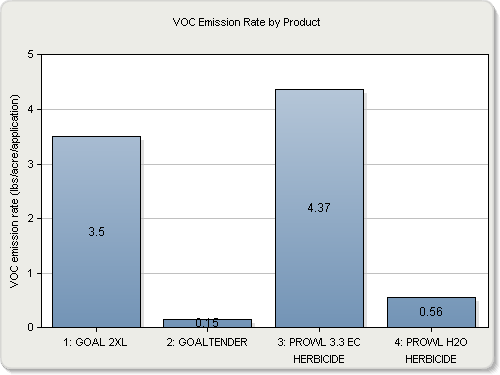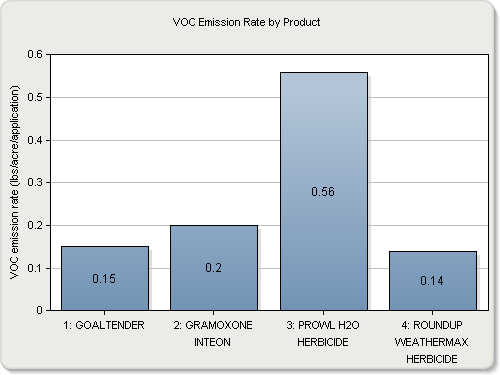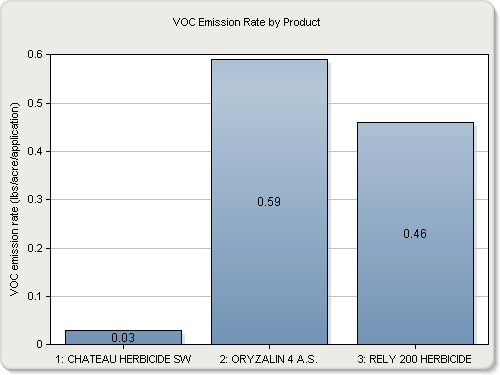Earlier this month, I attended the 2011 Plant and Soil Conference which was held in Fresno this year. This annual meeting put on by the California Chapter of the American Society of Agronomy (http://calasa.ucdavis.edu/ ) usually has several sessions during the two-day program designed to update Certified Crop Advisors, Pest Control Advisors, and other professional agronomists on current research and regulatory issues. One of the speakers in the Environmental Quality Session, Pam Wofford from CDPR, spoke about reducing emissions of Volatile Organic Compounds (VOC) from pesticides by switching formulations. I thought I’d touch on that issue today.
There are a number of definitions of VOCs based on the chemical and physical properties of molecules but we are generally talking about a large group of carbon-based chemicals that easily evaporate at room temperature. Examples include solvents in paints or adhesives, fuels and cleaners, plasticizers, foam and styrofoam, perfumes and deodorants among many others. These compounds can have direct health effects which is one of the reasons for regulations on indoor air quality. In the atmosphere, VOCs can interact with nitrous oxide (NOX) emissions from vehicles and form ground level smog – this is one reason why heavily populated areas (many vehicles) with large agricultural or manufacturing industries (high VOC) often have poor air quality. Air quality regulations by US-EPA and California Air Resource Board are of particular interest to this audience because of the VOC content of fumigant and non-fumigant pesticides.
In recent years, there has been a considerable research and regulatory focus on VOC emissions from soil fumigants. I discussed some of our recent research in my post from a few weeks ago (January 24, 2011). The fumigants were the natural starting point for VOC emission reduction efforts because 1) they are used at very high rates, 2) there are relatively few applicators (professional applicators only), and 3) there are only a few active ingredients.
Although progress is being made on reducing fumigant VOC emissions, the reductions from these pesticdes are not enough to meet target levels in some air basis as required by the federal Clean Air Act and California's State Implementation Plan (SIP) for meeting air quality standards. Towards this end, CDPR will be tracking and reduce pesticide VOC emissions. Information on this program can be found here. According to Pam Wofford’s presentation, DPR is initially focusing on seven non-fumigant active ingredients: abemectin, chlorpyrifos, dimethoate, gibberellins, permiethrin, and the herbicides oxyfluorfen (Goal) and trifluralin (Treflan) (Pam's short paper is on page 166 here).
The “VOC Emission Calculator” http://apps.cdpr.ca.gov/voc-calculator/ tool developed by CDPR is a very interesting and enlightening tool. This interactive webtool can calculate VOC emissions from single applications or from a multi-pesticide product application. First, select a crop site, then click on a Product from the list (hold down “ctrl” and click to select multiple products.). Then enter an application rate, treated acreage, and number of applications. Review your selections and then hit “calculate”. For this exercise, I did two calculations using common almond herbicides.
First, I compared the VOC contributions of a 20-acre, single application of two common products that have both a “regular” formulation and a “low VOC” formulation so I compared equivelent rates of pendimethalin (Prowl 3.3 EC vs Prowl H2O) and oxyfluorfen (Goal 2XL vs GoalTender). See the attached pdf report for an example of this output. Using Prowl H20 instead of Prowl 3.3 EC resulted in an 87% reduction in VOC emissions. Similarly, using GoalTender instead of Goal 2XL at equivalent rates resulted in a 96% reduction. It’s pretty easy to see that, if weed control efficacy can be maintained, switching formulations makes a lot of sense from an environmental standpoint.

In my second simulation, I entered in the details for a program with a dormant application of 4 qt / A Prowl H2O plus 5 pt GoalTender plus 1 qt Roundup WeatherMax followed by a spring application of 1qt Roundup WeatherMax and a preharvest application of 3 pt Gramoxone Inteon. This had a total VOC emission of about 1.2 lb VOC per acre. I compared this to another program of 4 qt/A Oryzalin 4AS plus 12 oz Chateau followed by two applications of 4 qt of Rely 200 (similar to 3 qt Rely 280 which is not yet in the database). This program had a total VOC emission of about 1.5 lb per acre.


I found this to be a really interesting tool for comparing the VOC emissions from various herbicides and weed control programs. It can also be used for other pesticides including insecticides and fungicides. These herbicides and other non-fumigant pesticides are likely to be more heavily regulated in the future - this tool can help us understand how we can contribute to better environmental stewardship.
Check it out. Brad
Attached Files: